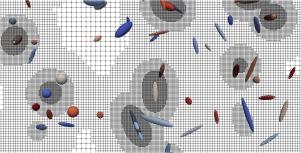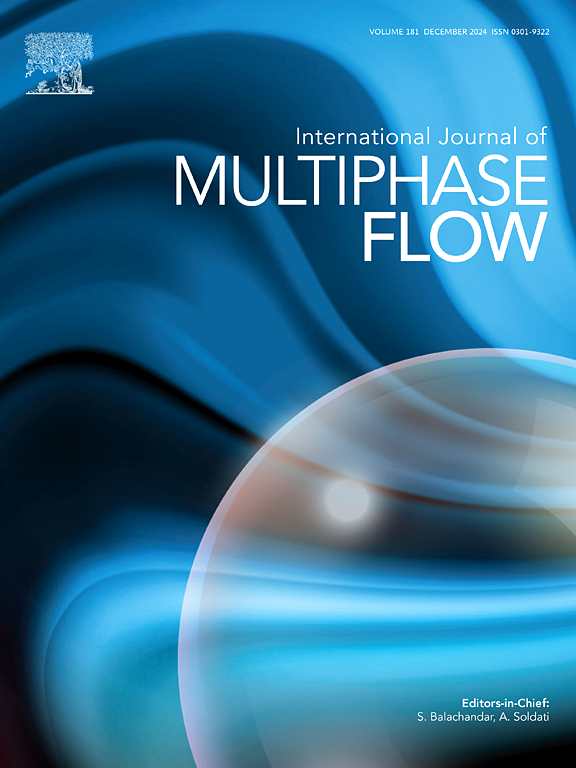湍流无管射流中球形和椭球颗粒的直接颗粒流体模拟
IF 3.8
2区 工程技术
Q1 MECHANICS
International Journal of Multiphase Flow
Pub Date : 2025-09-10
DOI:10.1016/j.ijmultiphaseflow.2025.105443
引用次数: 0
摘要
采用颗粒-流体直接模拟方法,分析了雷诺数ReD=15546时球形和椭球状颗粒在无管射流耦合湍流中的动力学特性。射流载荷为长径比为1≤β≤8的球形和椭球状颗粒,由湍流周期性管道流提供体积载荷6.67×10−4。流场预测采用自适应精细笛卡尔网格的有限体积公式。每个粒子都用切槽法完全分解。该方法保证了流体-粒子界面处质量、动量和能量的守恒。为了确保物理上正确的颗粒分布和流场特征,采用切片技术来确定同时计算的满载颗粒的完全发展的湍流管道流的瞬时解,该流定义了射流的流入边界分布。在完全发展的湍流管道和自由射流中,流体和粒子的统计量是相互独立的。分析了优先粒子分布、取向和时间平均能量交换率,重点分析了不同粒子长径比的影响。在紊流管内,椭球粒子比球形粒子更接近粒子中心。此外,能量交换速率和粒子诱导的耗散趋于不同,各向异性粒子与靠近管壁的流体交换更多的能量。颗粒对管道流动的冲击影响着湍流自由射流的形成,而颗粒的冲击是自由射流的流入条件。总的来说,由于流体耗散速率的增加,颗粒负载湍流自由射流的扩散速率降低。此外,由于非球形颗粒的存在,流体的动能降低了9%,湍流强度降低了约9%。近场尽头20%本文章由计算机程序翻译,如有差异,请以英文原文为准。

Direct particle–fluid simulation of spherical and ellipsoidal particles in turbulent pipe-free-jet flow
The dynamics of spherical and ellipsoidal particles in coupled turbulent pipe-free-jet flow at Reynolds number is analyzed by direct particle–fluid simulation. The jet is laden with spherical and ellipsoidal particles with aspect ratios in the range with a volume loading of supplied by turbulent periodic pipe flow. The flow field is predicted using a finite-volume formulation on an adaptively refined Cartesian mesh. Each particle is fully resolved by a cut-cell method. The method guarantees the conservation of mass, momentum, and energy at the fluid–particle interfaces. To ensure physically correct particle distributions and flow field characteristics, a slicing technique is used to determine the instantaneous solution of a simultaneously computed particle–laden fully-developed turbulent pipe flow that defines the inflow boundary distribution of the jet. The fluid and particle statistics within fully-developed turbulent pipe and free jet flow are investigated independent from each other. Preferential particle distributions, orientations, and time-averaged energy exchange rates are analyzed with emphasis on the impact of the varying particle aspect ratios. The ellipsoidal particles tend to align closer to the particle center than spherical particles in the turbulent pipe. Furthermore, the energy exchange rates and the particle-induced dissipation tend to differ such that the anisotropic particles exchange more energy with the fluid close to the pipe wall. The impact of the particles on the pipe flow influences the turbulent free jet flow for which it serves as inflow condition. Overall, the spreading rate of the particle–laden turbulent free jet is reduced due to the increased fluid dissipation rate. Furthermore, due to the non-spherical particles the kinetic energy of the fluid is lowered by 9% and the turbulence intensity is decreased by approx. 20% at the end of the near field.
求助全文
通过发布文献求助,成功后即可免费获取论文全文。
去求助
来源期刊
CiteScore
7.30
自引率
10.50%
发文量
244
审稿时长
4 months
期刊介绍:
The International Journal of Multiphase Flow publishes analytical, numerical and experimental articles of lasting interest. The scope of the journal includes all aspects of mass, momentum and energy exchange phenomena among different phases such as occur in disperse flows, gas–liquid and liquid–liquid flows, flows in porous media, boiling, granular flows and others.
The journal publishes full papers, brief communications and conference announcements.

 求助内容:
求助内容: 应助结果提醒方式:
应助结果提醒方式:


